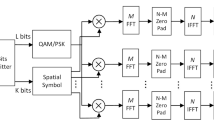Abstract
In the conventional beamforming-based transmitting scheme for a multiple-input single-output (MISO) system, many transmitting antennas are usually required. In this paper, a direction of arrival (DOA) based spatial focusing scheme for a 2 × 1 MISO system is proposed. This 2 × 1 MISO system, can be employed for local or indoor communications, requires only one single and two antennas at the mobile station and the base station respectively. In the system, orthogonal-frequency-division-multiplexing (OFDM) is employed for the uplink and ultra wide band pulse is employed for the downlink. Firstly, based on the characteristics of OFDM, a multi-carriers DOA estimation algorithm is proposed to estimate the DOAs of multiple OFDM signals by using only two antennas, even the signals are coherent. Secondly, by using a fusion approach which fuses the estimated DOAs and an existing fixed focusing method, the spatial information focusing for mobile multi-users can be achieved. Numerical examples are provided to demonstrate the effectiveness of the proposed approach.






Similar content being viewed by others
References
Zhang, C., Ariyavisitakul, S. L., & Meixia, T. (2012). LTE-advanced and 4G wireless communications [Guest Editorial]. IEEE Communications Magazine, 50, 102–103.
Li, Y., Vorobyov, S. A., & Koivunen, V. (2015). Ambiguity function of the transmit beamspace-based MIMO radar. IEEE Transactions on Signal Processing, 63, 4445–4457.
van Rensburg, C., & Friedlander, B. (2004). Transmit diversity for arrays in correlated Rayleigh fading. IEEE Transactions on Vehicular Technology, 53, 1726–1734.
Seok-Hwan, P., Haewook, P., & Inkyu, L. (2010). Distributed beamforming techniques for weighted sum-rate maximization in MISO interference channels. IEEE Communications Letters, 14, 1131–1133.
Wu, S. X., Qiang, L., So, A. M. C., & Wing-Kin, M. (2015). Rank-two beamforming and stochastic beamforming for MISO physical-layer multicasting with finite-alphabet inputs. IEEE Signal Processing Letters, 22, 1614–1618.
Duarte, M., Sabharwal, A., Dick, C., & Rao, R. (2010). Beamforming in MISO systems: Empirical results and EVM-based analysis. IEEE Transactions on Wireless Communications, 9, 3214–3225.
Feng, W., Tao, P., Yongwei, H., & Xin, W. (2015). Robust transceiver optimization for power-splitting based downlink MISO SWIPT systems. IEEE Signal Processing Lette, 22, 1492–1496.
Fan-Shuo, T., & Jhen-Fong, G. (2015). Robust beamforming design in MISO interference channels with RVQ limited feedback. IEEE Transactions on Vehicular Technology, 64, 580–592.
Mavridis, T., Sarrazin, J., Petrillo, L., De Doncker, P., & Benlarbi-Delai, A. (2015). Information spatial focusing scheme for UWB wireless communications in smart environments. IEEE Antennas and Wireless Propagation Letters, 14, 20–23.
Knapp, C. C., & Clifford, G. (1976). the generalized correlation method for estimation of time delay. IEEE Transactions on Acoustics, Speech, and Signal Processing, 24, 8.
Zhang, W. Y., & Rao, B. D. (2010). A two microphone-based approach for source localization of multiple speech sources. IEEE Transactions on Audio, Speech and Language Processing, 18, 1913–1928.
Yang, J.-M. (2008). Two-channel DOA estimation using frequency selective MUSIC algorithm with a phase compensation in reverberant room. In 2008 IEEE 5th proceedings of the Sensor Array and Multichannel Signal Processing Workshop(SAM), pp. 365–368.
Jian-Feng, G., Nan-Jun, L., Ping, W., & Heng-Ming, T. (2010). Wideband DOA estimation using two sensors. In 2010 International conference on measuring technology and mechatronics automation (ICMTMA), pp. 1095–1098.
Yong, Z., & Peiyu, H. (2012). Wideband direction of arrival estimation based on multiple virtual extension arrays. In: 2012 IEEE 11th international conference on signal processing (ICSP), pp. 343–346.
van Nee, R. P. R. (1999). OFDM for wireless multimedia communications (p. 34). Boston: ARTech House.
Fang-Ming, H., & Xian-Da, Z. (2005). An ESPRIT-like algorithm for coherent DOA estimation. IEEE Antennas and Wireless Propagation Letters, 4, 443–446.
Schmidt, R. O. (1982). A signal subspace approach to multiple emitter location and spectral estimation. Ph.D. dissertation, Stanford University, California.
Golub, G. H., & Van Loan, C. F. (1996). Matrix computations (3rd ed., pp. 603–604). Baltimore: Johns Hopkins University Press.
Knyazev, A. V. (2002). Principal angles between subspaces in an A-based scalar product: Algorithms and perturbation estimates. Society for Industrial and Applied Mathematics, 23, 2009–2041.
Kaiser, T., & Zheng, F. (2010). Ultra wideband systems with MIMO (pp. 99–133). Hoboken, NJ: Wiley.
Rappaport, T. S. (1996). Wireless communications: Principles and practice (Vol. 2). Upper Saddle River, NJ: Prentice-Hall.
Yong, Z., Peiyu, H., & Haijiang, W. (2016). Wideband coherent sources localization based on a two-node distributed sensor networks. Signal Processing, 126, 103–110.
Acknowledgements
The work in this paper was supported by the National Natural Science Foundation of China (Grant No. 61071159), the National High Technology Research and Development Program of China (863 Program) (Grant No. 2012AA01A502), the National Natural Science Foundation of China (Grant No. 61179006), and the Science and Technology Support Program of Sichuan Province (Grant No. 2014GZX0004).
Author information
Authors and Affiliations
Corresponding author
Rights and permissions
About this article
Cite this article
Zhang, Y., Zhu, L., He, P. et al. A DOA-Based Spatial Information Focusing Scheme for Mobile Multi-users in A 2 × 1 MISO System. Wireless Pers Commun 96, 1835–1848 (2017). https://doi.org/10.1007/s11277-017-4271-7
Published:
Issue Date:
DOI: https://doi.org/10.1007/s11277-017-4271-7




